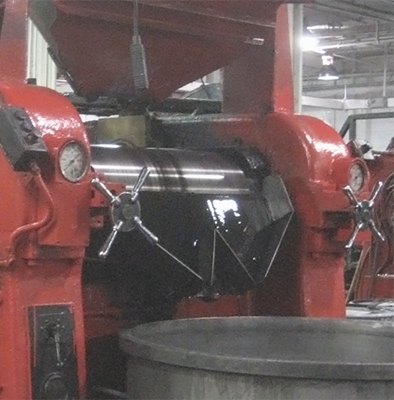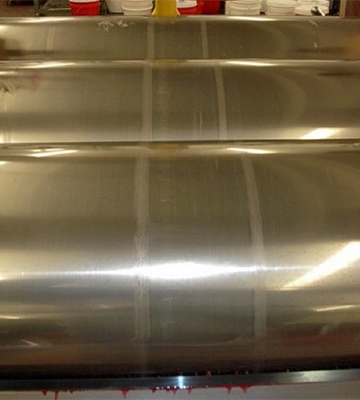Last week I had conversations with three customers, and these conversations got into the subject of roll condition in general, and more specifically, how do you know when a roll set needs to be ground. As I get these questions every week, this topic will be the subject of my column. As in my previous columns, I would like to offer this invitation and this promise. If you have a question regarding TRMS, please email that question to me (jon.hatz@keithmachinery.com), and I promise to answer it. It is my intension to have your questions drive the content of these columns. And now, here I go with my next column.
There are quite a few issues that will cause rolls to need roll grinding, but all of these have a common factor, and that factor is that the product is not being ground as well as it once was.
Vertical Burn Marks
The most common problem that KMC observes when roll sets are sent to us for grinding are vertical bands (burn marks) that

can appear at one location or at multiple locations on the face of the roll. The photo to the left shows a three roll mill (TRM) with vertical burn marks. The most common reason for these burn marks is that the rolls have been allowed to run dry.
Typically, at the end of the run, the operator will run out the product in the feed nip, before opening the rolls for cleaning. In most instances, the operator will catch this problem immediately, and no harm will have been done. But sometimes the operator may be distracted, and the rolls will “gall or tear” were the feed roll and the center roll are running against each other, with no product present for lubrication. Other causes for these burn marks would be for some foreign substance to pass through the feed nip. This could be shot from a horizontal media mill, or it could even be a spatula passing through the feed nip. Sometimes these vertical bands show as discoloration only, and they can’t be felt. More often, the tear can be felt by running a fingertip along the roll surface. Once a burn mark appears on the feed or center roll, it typically transfers to the other rolls in the roll set.
Once burn marks are present, the product will be ground differently (worse) at the burn mark site then it is ground along the rest

of the roll. Also, the product may need more apron knife pressure to scrape off the product from the apron roll. The knife pressure issue is not the major problem, and so long as the product can be completely scraped off of the apron roll, the only result is that apron knives will wear out faster than they did before.
The major problem with burn marks is grind issue. If the burn marks are not too bad, the product coming off at the burn mark site can get to an acceptable grind by increasing roll pressure. Of course, increasing roll pressure decreases throughput (production) on the affected TRM. Also, the product coming off the apron roll is no longer uniform, with the product coming off the non-burnt sections now having a finer grind.

The previous paragraph describes the best case. In many cases, these burn marks can be deeper and or wider. In such cases, increasing roll pressure will never get the product coming off the burn mark site to an acceptable grind. Also, burn marks tend to get worse over time. The end result is the same: when the roll set will no longer yield an acceptable grind, or when the product uniformity becomes too great, then the roll set needs to be ground.
Corrugation
Another problem that KMC observes when rolls are sent to us for grinding appear to the eye as horizontal lines that go across the roll surface. The drawing below shows this phenomenon, and it is called corrugation.

Although there are a number of reasons for corrugation to occur, it is almost always associated with water-based products, as water is a very poor lubricant. Once corrugation appears, it gets progressively worse. At its worse, a TRM with corrugated rolls will sound like a machine gun. As with burn marks, at the very early stages of corrugation, the grind can be maintained by increasing roll pressure. But as corrugation quickly gets worse and worse, roll grinding is always required. Customers that run products that cause corrugation typically schedule roll grinding in two to three year cycles. With that said, KMC has one customer that has multiple RRRS (ready reserve roll sets), with roll sets never in use for more than one year.
Normal Wear
As a TRM is used to grind product, the rolls will wear (abrade) due to friction. Over time, the crowns will wear away, and the shape of the rolls will not be as they were when they left the factory. This type of wear is product dependent. The most benign products, such as artist colors in oil, wear the rolls very slowly, and the roll grinding cycle for these benign products is normally grinding every 10-12 years or so. At the other end of the spectrum are abrasive products that can easily require grinding every year. With this type of normal wear, the rolls often look perfectly shiny & nice. The problem shows itself in that the product will take more passes to get to acceptable grind, or it will take a higher roll pressure, etc. etc.
Roll Grinding Options
When it is determined that a roll set needs grinding, the owner of the TRM has a number of options. These options include a ROLL SET JOB (RSJ) where the roll set is sent out for grinding. In this case the TRM will be down for at least 8 weeks. Another option is a ROLL SET SWITCH (RSS) where a remanufactured roll set is supplied to the owner, and eventually the existing roll set is sent back to the supplier. With an RSS the TRM will only be down for a week. Another option is to send the entire TRM to be remanufactured. With a REMANUFACTURE, the TRM will be down for at least 12 weeks. And the last option is a MILL SWITCH, where a remanufactured TRM is supplied, and the existing TRM is sent back to the supplier. With a MILL SWITCH, the TRM is only out of service for a day or so. These options will be discussed in my next two columns.
There are quite a few issues that will cause rolls to need roll grinding, but all of these have a common factor, and that factor is that the product is not being ground as well as it once was.
Vertical Burn Marks
The most common problem that KMC observes when roll sets are sent to us for grinding are vertical bands (burn marks) that

Typically, at the end of the run, the operator will run out the product in the feed nip, before opening the rolls for cleaning. In most instances, the operator will catch this problem immediately, and no harm will have been done. But sometimes the operator may be distracted, and the rolls will “gall or tear” were the feed roll and the center roll are running against each other, with no product present for lubrication. Other causes for these burn marks would be for some foreign substance to pass through the feed nip. This could be shot from a horizontal media mill, or it could even be a spatula passing through the feed nip. Sometimes these vertical bands show as discoloration only, and they can’t be felt. More often, the tear can be felt by running a fingertip along the roll surface. Once a burn mark appears on the feed or center roll, it typically transfers to the other rolls in the roll set.
Once burn marks are present, the product will be ground differently (worse) at the burn mark site then it is ground along the rest

The major problem with burn marks is grind issue. If the burn marks are not too bad, the product coming off at the burn mark site can get to an acceptable grind by increasing roll pressure. Of course, increasing roll pressure decreases throughput (production) on the affected TRM. Also, the product coming off the apron roll is no longer uniform, with the product coming off the non-burnt sections now having a finer grind.

Corrugation
Another problem that KMC observes when rolls are sent to us for grinding appear to the eye as horizontal lines that go across the roll surface. The drawing below shows this phenomenon, and it is called corrugation.

Although there are a number of reasons for corrugation to occur, it is almost always associated with water-based products, as water is a very poor lubricant. Once corrugation appears, it gets progressively worse. At its worse, a TRM with corrugated rolls will sound like a machine gun. As with burn marks, at the very early stages of corrugation, the grind can be maintained by increasing roll pressure. But as corrugation quickly gets worse and worse, roll grinding is always required. Customers that run products that cause corrugation typically schedule roll grinding in two to three year cycles. With that said, KMC has one customer that has multiple RRRS (ready reserve roll sets), with roll sets never in use for more than one year.
Normal Wear
As a TRM is used to grind product, the rolls will wear (abrade) due to friction. Over time, the crowns will wear away, and the shape of the rolls will not be as they were when they left the factory. This type of wear is product dependent. The most benign products, such as artist colors in oil, wear the rolls very slowly, and the roll grinding cycle for these benign products is normally grinding every 10-12 years or so. At the other end of the spectrum are abrasive products that can easily require grinding every year. With this type of normal wear, the rolls often look perfectly shiny & nice. The problem shows itself in that the product will take more passes to get to acceptable grind, or it will take a higher roll pressure, etc. etc.
Roll Grinding Options
When it is determined that a roll set needs grinding, the owner of the TRM has a number of options. These options include a ROLL SET JOB (RSJ) where the roll set is sent out for grinding. In this case the TRM will be down for at least 8 weeks. Another option is a ROLL SET SWITCH (RSS) where a remanufactured roll set is supplied to the owner, and eventually the existing roll set is sent back to the supplier. With an RSS the TRM will only be down for a week. Another option is to send the entire TRM to be remanufactured. With a REMANUFACTURE, the TRM will be down for at least 12 weeks. And the last option is a MILL SWITCH, where a remanufactured TRM is supplied, and the existing TRM is sent back to the supplier. With a MILL SWITCH, the TRM is only out of service for a day or so. These options will be discussed in my next two columns.











